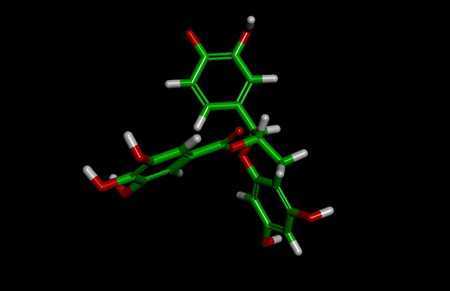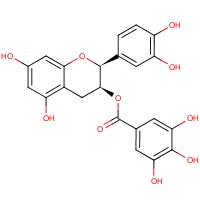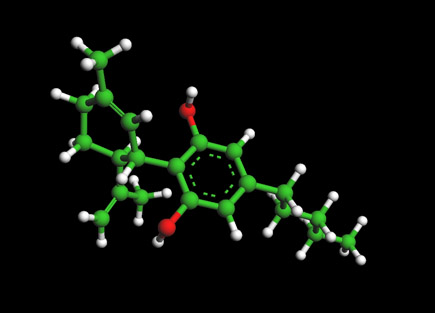EGCG Molecule - Most active component of green tea

EGCG Molecule from Green Tea
Chemical structure Epigallocatechin gallate(EGCG), also known as epigallocatechin 3-gallate, is the ester of epigallocatechin and gallic acid, and is a type of catechin.
Molecular formula C22H18O11
Molar mass 458.37 g mol-1

Medicinal Properties
EGCG
is the most abundant catechin in tea and
is a potent antioxidant that may have
therapeutic applications in the treatment
of many disorders (e.g. cancer). It is
found in green - but not black - tea,
as EGCG is converted into thearubigins
in black teas. In a high temperature environment,
an epimerization change is more likely
to occur; however as exposure to boiling
water for 30 straight minutes only leads
to a 12.4% reduction in the total amount
of EGCG, the amount lost in a brief exposure
is insignificant. In fact, even when special
conditions were used to create temperatures
well over that of boiling water, the amount
lost scaled up only slightly.EGCG
can be found in many supplements.
EGCG
A recent study using mouse models at the University of Southern California showed that, in contrast to the myriad benefits commonly associated with green tea and green tea extract (GTE), EGCG binds with the anti-cancer drug Velcade, significantly reducing its bioavailability and thereby rendering it therapeutically useless. Dr. Schönthal, who headed the study, suggests that consumption of green tea and GTE products be strongly contraindicated for patients undergoing treatment for multiple myeloma and mantle cell lymphoma. EGCG has a slight stimulatory effect due to it increasing adrenaline levels. Epigallocatechin-3-gallate, may reduce the bioavaialbilty of the drug sunitinib when they are taken together.
EGCG was, among other tea polyphenols, found to be a strong topoisomerase inhibitor, similar to some chemotherapeutic anticancer drugs, for example, etoposide and doxorubicin. This property may be responsible for anticarcinogenic however also a carcinogenic potential of the substance. High intake of polyphenolic compounds during pregnancy is suspected to increase risk of neonatal leukemia. Bioflavonoid supplements should not be used by pregnant women.A strong association between high intake of tea during pregnancy and elevated risk of childhood malignant central nervous system (CNS) tumours was found.Bioavailability of EGCG
The bioavailability of the most abundant and most active green tea antioxidant, epigallocatechin gallate (EGCG) remains uncertain. see abstracts below....
Abstracts:
19 Nov 2018 -- Epigallocatechin gallate suppresses premature senescence of preadipocytes by inhibition of PI3K/Akt/mTOR pathway and induces senescent cell death by regulation of Bax/Bcl-2 pathway.
The phytochemical epigallocatechin gallate (EGCG) has been reported to alleviate age-associated immune disorders and organ dysfunction. However, information regarding the mechanistic role of EGCG in the suppression of cellular senescence is limited. The present study thus assessed the effects and underlying mechanisms of EGCG in the inhibition of senescence as well as its potential to selectively eliminate senescent cells (senolytics) using 3T3-L1 preadipocytes. Premature senescence was established in cells by repeated exposure of H2O2 at a sub-lethal concentration (150 μM). H2O2 treated cells showed characteristic senescence-associated features including increased cell size, senescence-associated β-galactosidase activity (SA-β-gal), development of senescence-associated secretory phenotype (SASP), activation of reactive oxygen species (ROS) and pathways, DNA damage as well as induction of cell cycle inhibitors (p53/p21WAF1/p16INK4a). In addition, a robust activation of PI3K/Akt/mTOR and AMPK pathways was also observed in H2O2 treated cells. Presence of EGCG (50 and 100 μM) showed significant downregulation of PI3K/Akt/mTOR and AMPK signaling along with the suppression of ROS, iNOS, Cox-2, NF-κB, SASP and p53 mediated cell cycle inhibition in preadipocytes. In addition, EGCG treatment also suppressed the accumulation of anti-apoptotic protein Bcl-2 in senescent cells thereby promoting apoptosis mediated cell death. Our results collectively show that EGCG acts as an mTOR inhibitor, SASP modulator as well as a potential senolytic agent thereby indicating its multi-faceted attributes that could be useful for developing anti-aging or age-delaying therapies. source27 May 2015 Food Inhibits the Oral Bioavailability of the Major Green Tea Antioxidant Epigallocatechin Gallate in Humans
The bioavailability of the most abundant and most active green tea antioxidant, epigallocatechin gallate (EGCG) remains uncertain. Therefore, the systemic absorption of EGCG was tested in healthy fasted humans. It was administered as capsules with water or with a light breakfast, or when incorporated within a strawberry sorbet. The results for plasma EGCG clearly revealed that taking EGCG capsules without food was better; the AUC was 2.7 and 3.9 times higher than when EGCG capsules were taken with a light breakfast (p = 0.044) or with EGCG imbedded in the strawberry sorbet (p = 0.019), respectively. This pattern was also observed for Cmax and Cav. Therefore, ingesting food at the same time as EGCG, whether it was imbedded or not in food, substantially inhibited the absorption of the catechin. As with some types of medications that are affected by food, it appears that EGCG should be taken without food in order to maximise its systemic absorption. Therefore, based on these findings, ingesting EGCG with water on an empty stomach is the most appropriate method for the oral delivery of EGCG in clinical trials where EGCG is to be investigated as a potential bioactive nutraceutical in humans. see full publication
8 October 2012 -- Preventive Effects of Epigallocatechin-3-O-Gallate againstReplicative Senescence Associated with p53 Acetylation in HumanDermal Fibroblasts
Considering the various pharmacological activities of epigallocatechin-3-O-gallate (EGCG) including anticancer, and anti-inflammatory, antidiabetic, and so forth, relatively less attention has been paid to the antiaging effectofEGCGonprimarycells.In this study, the preventive effects of EGCG against serial passage-induced senescence were investigated in primary cells includingrat vascular smooth muscle cells (RVSMCs), human dermal fibroblasts (HDFs), and human articular chondrocytes (HACs). Theinvolvement of Sirt1 and acetylated p53 was examined as an underlying mechanism for the senescence preventive activity of EGCGin HDFs. All cells were employed with the initial passage number (PN) between 3 and 7. For inducing senescence, the cells wereserially passaged at the predetermined times and intervals in the absence or presence of EGCG (50 or 100μM). Serial passage-induced senescence in RVSMCs and HACs was able to be significantly prevented at 50μM EGCG, while in HDFs, 100μMEGCGcould significantly prevent senescence and recover their cell cycle progression close to the normal level. Furthermore, EGCG wasfound to prevent serial passage- and H2O2-induced senescence in HDFs by suppressing p53 acetylation, but the Sirt1 activity wasunaffected. In addition, proliferating HDFs showed similar cellular uptake of FITC-conjugated EGCG into the cytoplasm withtheir senescent counterparts but different nuclear translocation of it from them, which would partly account for the differentialresponses to EGCG in proliferating versus senescent cells. Taking these results into consideration, it is suggested that EGCG maybe exploited to craft strategies for the development of an antiaging or age-delaying agent.
Anti-Aging and Senolytics Home Page
- What is Anti-Aging Medicine
- What is Senescence?
- What are Senolytics?
- About Caloric Restriction
- Mtor and Rapamycin
- The IKK/NF-κB signaling pathway in aging
- Exercise and Anti-Aging
- Meditation and Anti-Aging
SENOLYTIC AND ANTI-AGING MOLECULES
RAPAMYCIN ---The mechanistic target of rapamycin (mTOR) pathway has a central role in cell activation...
METFORMIN -- The diabetes drug metformin used by some for anti-aging may diminish benefits of aerobic exercise...
QUERCETIN-- AND WITH DASATINIB--The senolytic cocktail, dasatinib plus quercetin, which causes selective elimination of senescent cells...
FISETIN--Of the 10 flavonoids tested, fisetin was the most potent senolytic...
EGCG- The most active component of green tea....
NAD BOOSTERS --'...The cells of the old mice were indistinguishable from the young mice, after just one week of treatment...
SULFORAPHANE-- An isothiocyanate present in cruciferous vegetables activates antioxidant and anti-inflammatory responses by ...
UROLITHIN --Metabolite of Pomegranate compound with anti-aging effects passes human trial...
MITO-Q -- A water soluble fomr of CoQ10 that has excellent absorption and high bioavailability...
HONOKIOL - A bioactive natural product derived from Magnolia Bark have demonstrated ...
CURCUMIN AND ANALOGS -Recent research is focused on the design and synthesis of curcumin analogs as antiproliferative and anti-inflammatory agents...
BERBERINE --berberine has recently been reported to expand life span in Drosophila melanogaster, and attenuate premature cellular senescence
N-ACETYL-CYSTINE (NAC)--"...pretreatment with NAC increased glutathione levels in the older cells and largely helped offset that level of cell death..."
PIPERLONGUMINE - A natural product from the Long pepper with high bioavailability...
RESVERATROL AND PTEROTSILBINE -- Pterostilben chemically similar to resveratrol bute differs from resveratrol by exhibiting increased bioavailability (80% compared to 20% in resveratrol)
SPERMIDINE--Spermidine delays aging in humans ...
ALLICIN -- Allicin is a compound produced when garlic is crushed or chopped. ...
VITAMIN D3 -- Production of the active forms of Vitamin D are reduced by 50% as a result of an age-related decline
VITAMIN K-- evidence suggests vitamin K has an anti-inflammatory action
TOCOTRIENOL(AND WITH QUERCETIN) --Tocotrieniols have been found to exert a synergistic antitumor effect on cancer cells when given in combination....
HSP-90 INHIBITORS --As a novel class of senolytics
The Cannabidiol Molecule
Cannabidiol (CBD is the major non-psychoactive component of Cannabis and is being looked at by major drug and consumer companies for various medical and social uses.